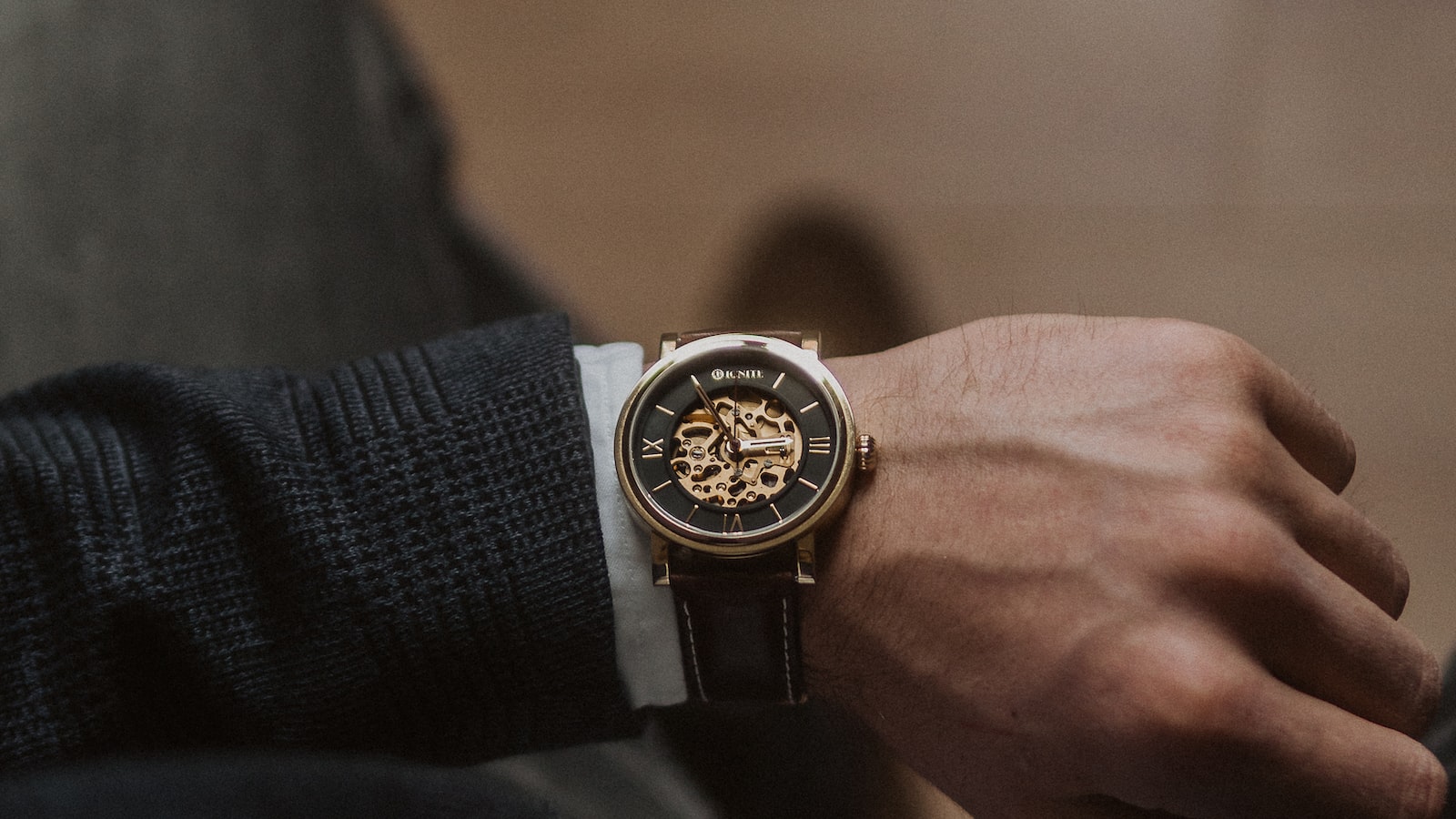In the age of smartphones, smartwatches and other wearable technology, it can be easy to forget that people still wear traditional watches. But the truth is that watches remain popular, even in the digital age. As a fashion accessory, a status symbol or simply for convenience, people around the world continue to wear watches. In this article, we’ll explore why people still wear watches today and discuss some of the different types available.Yes, people still wear watches. Watches remain a popular fashion accessory and are still seen as a symbol of style and sophistication. Many people enjoy the classic look of a watch and find it to be an attractive accessory for any outfit. Additionally, watches are also useful for keeping track of time and can be quite handy in many situations where checking your phone is not an option.
Types of Watches Worn by People
One of the most popular accessories worn by people are watches. Watches come in a variety of styles and designs, from classic analog watches to modern digital displays. There are many different types of watches that people can choose from, depending on their individual style and preference.
Analog watches feature a traditional design, with hands that rotate around the face of the watch to indicate the time. They may have additional features such as a date window or sub-dials that count seconds, minutes or hours. Analog watches come in a range of materials, including metal, leather, and plastic bands.
Digital watches feature an LCD or LED display that can show the time in either 24-hour format or 12-hour format. They often have additional features such as stopwatches, alarms, and timers. Digital watches typically have plastic or rubber bands that make them lighter and more comfortable to wear than analog watches.
Smartwatches are becoming increasingly popular among people who want more features than what is offered by traditional analog and digital watches. Smartwatches are like mini computers on your wrist, offering functions such as GPS tracking, music playback control, notifications from your phone and even fitness tracking capabilities. Some models even allow you to make phone calls directly from your wrist using Bluetooth technology.
In addition to these types of watches, there are now hybrid models that combine both analog and digital elements into one design. These models typically have an analog display with some digital elements such as date windows or sub-dials. Hybrid models usually come with interchangeable bands so you can easily switch up your look depending on your outfit or moods.
No matter what type of watch you choose to wear, it is important to find one that fits comfortably on your wrist and reflects your personal style. Watches are an accessory that can help you express yourself while still keeping track of time!
Advantages of Wearing a Watch
Watches are more than just an accessory; they provide a range of advantages that can help wearers in their everyday lives. One of the greatest advantages of wearing a watch is convenience. Watches allow you to quickly and easily check the time with just a glance, eliminating the need to fumble for your phone or search for the nearest clock. Additionally, watches can be used as a fashion statement, allowing you to express yourself and make a style statement.
Watches also offer practical benefits such as helping you stay on track and organized. If you often find yourself running late or forgetting appointments, setting reminders on your watch can be an effective way to stay on top of your schedule. Watches also provide health benefits by helping you keep track of how active you are throughout the day. Many modern watches come with built-in activity trackers that can monitor your heart rate, steps taken, and other important metrics that can give you insight into your overall health and wellbeing.
Finally, watches offer a level of security that other timekeeping devices cannot match. Unlike phones and other electronics, watches do not require batteries or power sources, meaning they will always tell the correct time even in an emergency situation when power may not be available. Additionally, most watches are small enough to fit comfortably on your wrist without being bulky or obtrusive, making them ideal for those who prefer discreet accessories.
Advantages of Wearing a Watch
Wearing a watch has its advantages. It’s a great way to stay organized and on time. It can also be an attractive fashion accessory, adding style and sophistication to your look. Watches can help you stay in touch with the world, providing you with important information about the time, date, and other events. Moreover, they are also useful for tracking fitness goals. Digital watches often come with features such as heart rate monitors and step counters that can be helpful when trying to stay active.
Disadvantages of Wearing a Watch
On the other hand, there are also some drawbacks to wearing a watch. For instance, if you’re not careful, it can become an addiction and you may find yourself constantly checking the time. Additionally, watches may interfere with your sleep by making it difficult to fall asleep without one or waking up in the middle of the night to check the time. Furthermore, watches are not always reliable as they may need regular maintenance or battery replacement in order to work properly. Finally, watches can be expensive if you opt for higher-end models with advanced features such as GPS tracking or fitness tracking capabilities.
Style and Design
The style and design of a watch is one of the most important factors when it comes to its popularity. Watches come in a wide range of styles, from classic and elegant dress watches to modern and sporty designs. Different watch designs appeal to different people, so it’s important for manufacturers to create watches that meet the needs and preferences of their customers. Watches can also be customized with different materials, such as gold, silver, or stainless steel, as well as with unique features such as chronographs or tourbillons. Aesthetic appeal is key when it comes to watches, and manufacturers are constantly striving for new designs that will draw in customers.
Functionality
Functionality is also an important factor when it comes to watch popularity. Watches are increasingly being used for more than just telling time; many now have features such as stopwatches and alarms that make them useful for athletes and other active individuals. Smartwatches are also becoming increasingly popular due to their ability to do things like track fitness data or display notifications from a smartphone. Manufacturers are always looking for ways to pack more functionality into their watches, so customers can get the most out of them.
Brand Recognition
Brand recognition plays a major role in the popularity of watches. Customers tend to favor recognizable brands that they trust for quality products, so having a strong brand presence can be essential for success in the watch industry. Many well-known brands have been around for decades, so they have built up trust among consumers over time. Brand recognition can give companies an edge in an increasingly competitive market where there are many options available from both established brands and newcomers alike.
Price
Price is another factor that can influence watch popularity. Generally speaking, people tend to gravitate towards watches that offer good value without sacrificing quality or style. Luxury watches may come with hefty price tags but they often come with additional features or higher-end materials that justify their cost. Conversely, budget-friendly options don’t always offer all the bells and whistles but they can provide good value at an affordable price point.

Impact of Smartphones on Watch Usage
The rapid rise of smartphones over the past few years has had an impact on many of our daily activities. The watch industry has been significantly affected, as newer devices can provide similar features and functionality that watches offer, such as timekeeping and tracking. Smartphones have become a popular choice for keeping track of time and other activities, leading to a decrease in watch usage.
Smartphones are convenient and easy to use, allowing users to access their data quickly from anywhere they go. This makes them a great choice for people who are always on the move or who need to stay in touch with their work. Furthermore, smartphones offer features like GPS tracking, which makes it easier for people to keep track of their location and activities. This has made them more appealing than watches for those who are looking for an all-in-one device to track their daily activities.
Another factor in the decreased usage of watches is the increasing availability of apps that can be used on smartphones. Apps like Fitbit can be used to monitor fitness levels, steps taken, and calories burned throughout the day. These apps are often more accurate than traditional watches due to their access to smartphone sensors and better functionality. As such, they have become a popular choice among those who want to keep track of their health and fitness levels without relying on a traditional watch.
In addition, many people find it easier and more convenient to use a smartphone than a watch because they can access the internet quickly from anywhere at any time. This allows them to stay connected with friends and family or access information quickly without having to look at their watch constantly. Furthermore, many modern smartphones come with features such as alarm clocks which make it easier for users to set reminders for themselves throughout the day instead of relying on a traditional watch or clock.
Overall, the increasing popularity of smartphones has had an impact on watch usage as users are now able to access similar features from their phones that used to only be available with watches. Smartphones offer convenience and easy access to data which makes them attractive for those who need quick information or reminders throughout the day. As such, they have become increasingly popular over traditional watches as users find them easier and more efficient when it comes to tracking daily activities or staying connected with friends and family members.
The Role of Technology in Modern-Day Watches
Watches have been around for centuries, but in the past few decades, technology has played an increasingly important role in the design and functionality of modern-day watches. As technology advances, so too does our ability to create more complex and advanced timepieces. From digital watches to smartwatches, technology has revolutionized the way we use and interact with our watches.
Digital watches are the most basic form of watch that uses technology. These timepieces feature a digital display that shows the time and other information such as the date or day of the week. Digital watches also often come with additional features such as alarms or stopwatch functions, making them more versatile than their analog counterparts.
Smartwatches are a more advanced type of watch that use wireless technology to connect to other devices such as smartphones. Smartwatches can be used to receive notifications from your smartphone, track your fitness level, make payments, access music and much more. Smartwatches can also be used as remote controls for home automation systems or even cameras.
The use of technology in watches has made them much more than just a way to tell the time. Modern-day watches are highly functional pieces of technology that can be used for a variety of tasks and activities. Technology has enabled us to create unique and innovative designs that offer enhanced functionality and convenience that were not possible before.
Social and Cultural Aspects of Watch Wearing
Watches have been a part of fashion for centuries. They are both a practical accessory, telling us the time, and a symbol of status, wealth, and power. A watch can be seen as an extension of our personality, with different styles conveying different messages to those around us. It is not just about telling the time; it is also about making a statement. Wearing a watch can be a way to express our identity, style, and values.
The types of watches we choose to wear can be influenced by many factors such as culture, religion, age, gender, income level and personal taste. Across cultures and countries there are differences in what types of watches people prefer. In some countries wearing an expensive watch may be seen as a sign of wealth or success whereas in other countries it may be seen as ostentatious or even vulgar. Similarly in some cultures wearing a wristwatch may be seen as more stylish than wearing a pocket watch.
Gender also plays an important role in the types of watches worn by men and women. Traditionally men’s watches have been more functional with utilitarian designs whereas women’s watches tend to be more decorative with delicate detailing such as jewels or stones set into the design. However this is changing with the rise of unisex designs that are being worn by both genders.
Age is another factor that influences watch wearing habits; older generations tend to prefer classic designs while younger generations may opt for more contemporary designs with cutting-edge technology such as smartwatches or fitness trackers. Income level can also affect what type of watch people choose to wear; luxury watches made from precious metals and gems can be prohibitively expensive for many people while affordable plastic or silicone models offer good value for money without compromising on style or quality.
Ultimately the choice of watch will depend on personal preference and lifestyle; whether it is used for practical purposes or simply to make a statement about who we are and where we come from, it will always remain an important part of our wardrobe.

Conclusion
The answer to the question “Do People Still Wear Watches?” is a resounding yes. Watches remain an important part of many people’s daily lives, providing both practical and aesthetic benefits. They are versatile accessories that are suitable for almost every occasion, from formal events to casual meetings. Moreover, with the emergence of smartwatches, there is a whole new range of possibilities for those looking to upgrade their watch-wearing experience.
Overall, watches can be seen as a timeless and classic accessory that will always remain popular among people of all ages and genders. As technology continues to advance and more innovative features are developed, it is likely that the watch-wearing tradition will remain alive and well for years to come.
Whether you’re looking for a practical time-telling device or an eye-catching fashion statement, watches have something to offer everyone. So the next time you’re out shopping for accessories, don’t forget to add a stylish watch to your collection!


